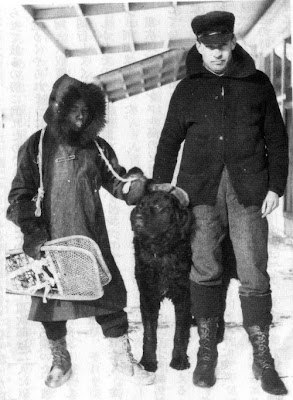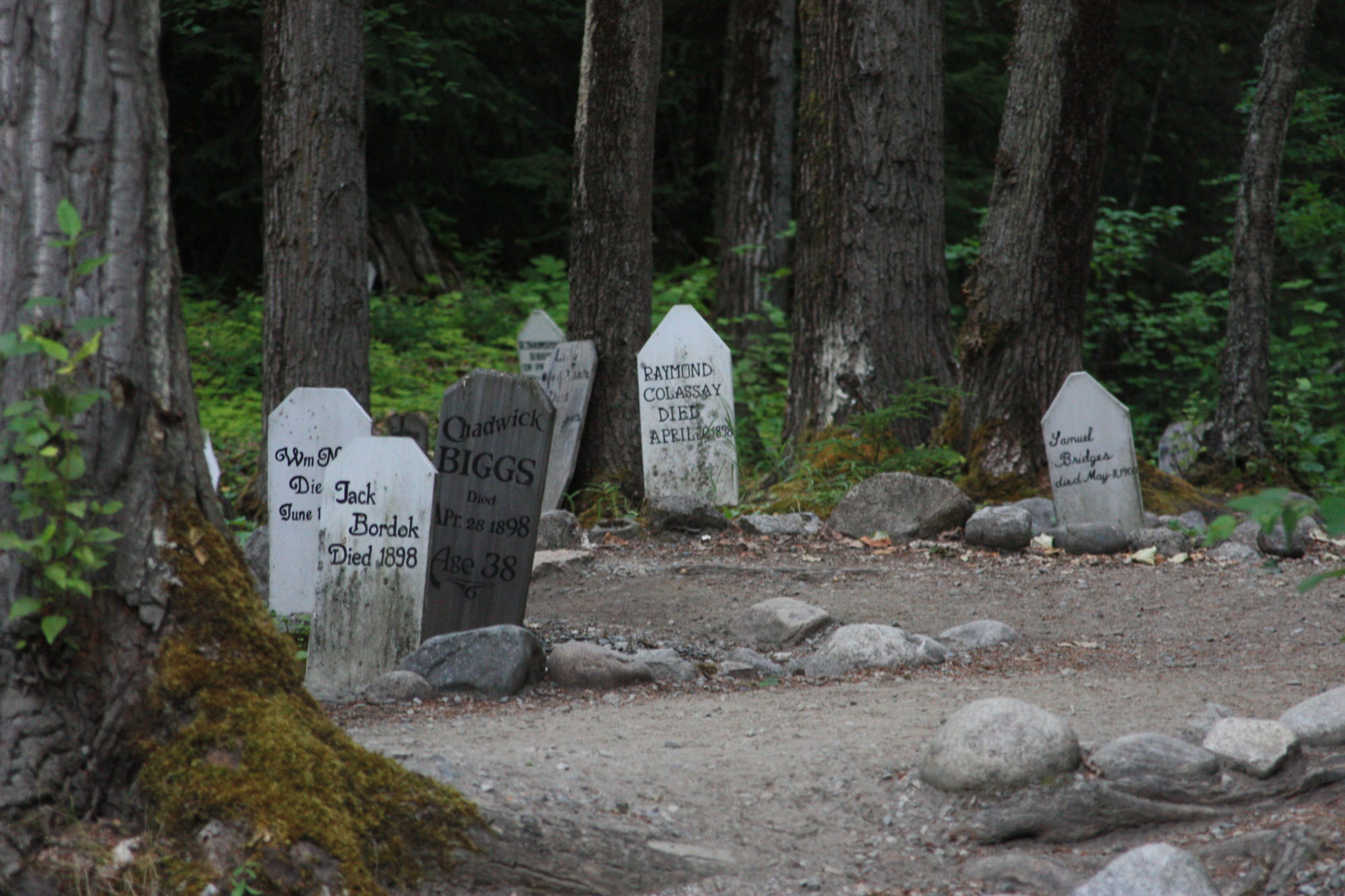
Ida May was Marshal Dillon’s daughter. She married Charles Olsen or Olson and on this day, June 24, 1908 she gave birth to a son, Philip E. Olson but unfortunately Ida May died in childbirth. She is buried in the Gold Rush Cemetery and has a delightful grave with a long flower pot on the top that often has wildflowers blooming.
Her son, Philip was adopted by Carl Larson and Edith Feero Larson. Philip stayed in Skagway and was a White Pass employee. His daughter still lives in Skagway part of the year. The Larsons went on to have four more kids, Stewart, Uremia, Ellen and Velma.
I have never heard what became of Charles Olson, his father, perhaps he was too young to care for his son and left town.
Ida May Dillon’s grave is seen just to the left of the new black platform above.
The Idaho

The sidewheeler Idaho was built in 1860 by John J. Holland when he was only 17 years old. Holland went on to build many more steamships.
It is said that the state of Idaho was actually named after this ship!
Anyway, it ran on the Columbia River taking passengers and cargo through the tricky rapids for many years. Captain John McNulty took her up and down the river for many years and made lots of money for the Oregon Steam Navigation Company.
In 1881 she was completely rebuilt with a new hull and paddle wheels at a cost of $20,000. In 1882 she ran the mouth of the Columbia several times before getting through, which was quite a feat at that time. She then made the fastest time up to the Puget Sound ever recorded. She worked various routes in the Sound until 1894 when she was sold to the junk firm of Cohn & Cohn. They removed the machinery and sold her to Dr. Alexander DeSoto. He refitted her as a charitable hospital for the returning gold rushers who were maimed and sick.
After 38 years of work it was fitting that the little Idaho served the poor as a hospital for 11 years. After that she gradually fell apart and became part of the harbor of the growing city of Seattle. There is a plaque there that remembers Dr. DeSoto and the hospital.
Wikipedia.
Pierre Humbert

Mr. Pierre Humbert Jr. was a millionaire Boston Banker who had a passion for moving things. So he started the Humbert Transportation Company and the Alaskan and Northwester Railway Company in 1898. He is most famous for transporting 200 cattle from Seattle to Haines to drive to Dawson to feed the starving miners in November 1897.
But even more amusing is the story which appeared in the Evening Times (Washington D.C.) of April 20, 1897 for Cripple Creek, Colorado on April 17.
“There is a report of an SOS which was dropped from an airship. Three crew members, Pierre Humbert of Boston, Massachusetts, C.J. Pillsbury, and C.D. Novina of Paris placed a note in a bottle and threw it at a witness on the ground. The note said that the airship had not been able to land for more than two weeks since landing in Kansas and that they had run out of food. It appeared that they had lost control of their vehicle and did not know whether they would survive the rest of the flight. It was not clear what the observer on the ground was expected to do. There is no report of an airship crashing anywhere in that year, so the final disposition of the crew is unknown.”
Well, obviously they did land and perhaps Mr. Humbert decided he would stick to land-based transportation following this little air adventure.
Minter p 125; Acts of the legislature of WV online; Kansas City Journal Nov 2, 1897;
Levi, Strauss and Company
Mr. F.A. Insly ran the Levi, Strauss Company sample room in Skagway, probably around 1900. A ‘sample room’ provided display space for the wares of visiting salesmen called ‘drummers’. This Barley photograph shows the various options someone would have in ordering. Reminds me of catalogs today and ordering online.
Frank Brown

From what I can tell there were at least three Frank Browns in Skagway. Frank W. Brown died on this day, June 19, 1907 in Skagway. Frank Edward Brown worked for White Pass in 1920. One Frank Brown was deported from Skagway after the Soapy roundup in 1898. But the most interesting story about Frank Brown is the one from 1988.
On January 26, 1988, the motorvessel Frank H. Brown, a 1965 Canadian cargo and fuel carrier was docked at the White Pass dock. This was one of the first container ships created but it must have lacked some safety features which are common today. That morning someone noticed the smell of gasoline and discoloration of the water around the stern tank of the ship. This tank had capacity of 124,000 gallons of fuel. Actions were immediately initiated to offload the tank to shoreside facilities. At the onset of the incident the wind was calm. However, by 10 a.m. the wind had built to nine knots from the north and continued increasing throughout the day. Response crews from the White Pass Transportation Co. initially boomed off the vessel but shortly thereafter opened the boom to avoid a fire hazard, on the advice of the U.S. Coast Guard. It was estimated that 2800 gallons of gasoline spilled into the harbor. Today Skagway still receives thousands of gallons of fuel and transfers it to fuel trucks which take the fuel to Whitehorse every day.
Seen above is the predecessor to the Brown, the Clifford Rogers as it unloads and loads containers (also invented by White Pass) to be loaded onto the train. This photo is from 1957 but is essentially the same as it was into the 1980’s.
USCG district 17. Government report 6547 online.
Lois Butt

Miss Lois Butt was a teacher in Skagway in 1915. I found reference to her in Nampa Idaho around the same time where they said she was a “tall red-headed old maid who was very stern”.
The picture above is a group of Skagway ladies in 1915 who were involved in the temperence movement. My guess is that Miss Butt is one of them. In my opinion they all look kinda frightening!
“Good morning Miss Butt!”
1915 Directory
Nantuck Murders

I recently got a new book called “Sailor on Snowshoes – Tracking Jack London’s Northern Trail” by Dick North. Mr. North has spent decades gathering every detail of London’s trip to Dyea and Dawson, but one incident jumped out at me that I had never heard before.
On page 81, he states that when the Nantucks spoke of “previous wrongs, it is very possible that it was the murder of the two maternal uncles of Johnny Johns they had in mind. ” Johnny Johns was the nephew of Skookum Jim Mason and Tagish Charlie. In 1982 Johnny Johns insisted that “very early in the gold rush era transgressions of the law occurred that were never reported because there were simply no law enforcement officers around. He cited the fate of his mother’s two brothers in 1896. When several white men who had set up camp on the beach at the outlet of Lake Lindeman caught an Atlin native stealing their liquor supply, they promptly shot the thief, killing him instantly. Seeing the only witnesses were two natives (who happened to be John’s mother’s brothers), they killed them as well. Word of the murders leaked out to the village people when the Native girlfriend of one of the whites told John’s mother about it.”
So, I looked through “Life Lived as a Story” by Julie Cruikshank and found the genealogy chart for Angela Sidney’s family. Johnny Johns’ mother was La.oos Tiaa, kaax’anshi or Maria Johns, married to Tagish John. Maria had two brothers who were named Tl’uku and Kult’us but there is no information on them.
Since the 1896 murder was not investigated and the murderers’ names were not recorded it would seem that in this case, they got away with murder. Then, two years later, on May 10, 1898 the Nantuck brothers take retribution for past occurrences, which presumably had to do with the white powder incident – or maybe something else.
North says that Johnny Johns’ family may have instead been referring to the 1896 murders.
An interesting thought might be that the two miners who murdered the brothers could possibly be the same two miners that the Nantucks shot in 1898.
The Nantuck brothers’ testimony seems confused, as written up in “Essays in the History of Canadian Law: British Columbia and the Yukon” by John McLaren and Hamar Foster which is viewable online. It was generally accepted that the Canadian government was trying to understand the issues involved in cases involving First Nations people and that they were beginning to rethink the previous frontier justice actions.
This week the remains of Dawson and Jim Nantuck were re-interred after they were identified in Dawson after accidentally being dug up during a construction project last summer. The Dawson cemetery is seen above.
Henry Havelock Norwood

Captain H.H. Norwood was born in 1859 in Berwick, Nova Scotia. He arrived on October 8, 1897 in Skagway with Zachary Taylor Wood and Walsh of the NWMP. Captain Norwood had spent time on the Arctic Whaler “Balaena” with the famous Japanese explorer Jujiro Wada.
Norwood taught Jujiro Wada to speak English, nautical skills and navigation. Wada made good use of these skills during a long adventurous life in Alaska.
The photo above might be Capt. Norwood with Jujiro.
Norwood sold some lucrative claims in the north and retired to San Francisco, California and died in 1917 in Sonoma.



